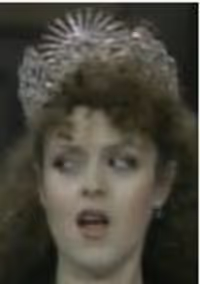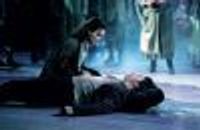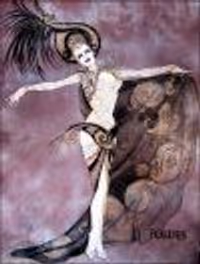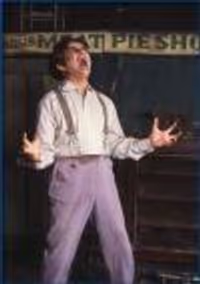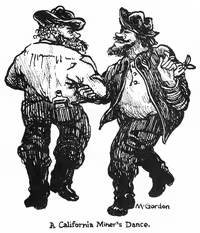Sweeney Todd
JeanGudio
Stand-by Joined: 6/9/12
#2Sweeney Todd
Posted: 6/16/12 at 7:22amI don't know. Do you WANT to go?
JeanGudio
Stand-by Joined: 6/9/12
#3Sweeney Todd
Posted: 6/16/12 at 7:38amYes apparently it is very good, go now.
JeanGudio
Stand-by Joined: 6/9/12
Owen22
Broadway Legend Joined: 2/24/11
#5Sweeney Todd
Posted: 6/16/12 at 7:58am
Go. Best Sweeney I've ever seen (and I've seen a bunch. Expertly directed, uniquely costumed (the setting has been bumped up to the 30's, if only to dress Mrs. Lovett in a more modern plaid with sleeves rolled up, and Sweeney in suspenders).
Imelda Staunton is magnificent! And Michael Ball is better than he's ever been.
#6Sweeney Todd
Posted: 6/16/12 at 11:00amIt's very good (not perfect) but you might benefit more posting this on the West End board.
The Scorpion
Leading Actor Joined: 1/3/07
#7Sweeney Todd
Posted: 6/16/12 at 11:09amWhat Owen22 said. Go. It's nice to have a fully-staged Sweeney with an orchestra and Staunton is absolutely perfect in the role, her performance is a tour de force. Direction-wise it seems to be based quite a lot on the Hal Prince original.
ActingDude172
Chorus Member Joined: 3/22/09
#8Sweeney Todd
Posted: 6/16/12 at 3:24pmWhy bump the setting up to the 1930s? You lose the integral Industrial Revolution commentary of the show.
#10Sweeney Todd
Posted: 6/16/12 at 5:00pm

"the setting has been bumped up to the 30's, if only to dress Mrs. Lovett in a more modern plaid with sleeves rolled up, and Sweeney in suspenders."
Sweeney in suspenders! What a revelation!
#11Sweeney Todd
Posted: 6/16/12 at 5:14pmi think setting the show in the 1930's (the Great Depression) makes perfect sense - gives new meaning to the '...times is hard..." line.
#12Sweeney Todd
Posted: 6/16/12 at 6:30pm^^ It would have more meaning if the production was more explicit with the setting from the beginning!
#13Sweeney Todd
Posted: 6/16/12 at 6:38pmI presume they've replaced the factory whistle with the drone of air raid sirens?
Broadway Legend
joined: 5/1/05
Blocked: After Eight, suestorm, david_fick, emlodik, lovebwy, Dave28282, joevitus, BorisTomashevsky, Seb28
#15Sweeney Todd
Posted: 6/16/12 at 6:47pmThe emphasis on the Industrial Revolution was Harold Prince's idea, and Sondheim has often said he was never a fan but put up with it anyway. I personally don't think it adds much to the piece (aside from the factory whistle), and the British factory stuff they shipped over and installed into the Uris (now the Gershwin) was probably a big reason why they ended in the red--the set alone cost somewhere around two million dollars if I remember correctly.
#16Sweeney Todd
Posted: 6/16/12 at 6:48pm
Though war was declared when the Germans invaded Poland in September of 1939, the Battle of Britain (the air attack by Germany on England) didn't begin until the spring or summer of 1940. In between, there was a sort of stalemate due to winter weather. Newspapers actually called it "The Phony War". Obviously that changed as WWII expanded in the 1940s.
So, no, the 1930s weren't air-raid siren years, except maybe an occasional drill.
#17Sweeney Todd
Posted: 6/16/12 at 6:56pm
The emphasis on the Industrial Revolution was Harold Prince's idea, and Sondheim has often said he was never a fan but put up with it anyway.
Then Sondheim is confused or just plain wrong. (This isn't to say the original set has to be used, just that the Industrial Revolution is central to the action of the play.)
The Industrial Revolution caused the population explosion that led to the policy of transporting criminals to Australia (rather than merely confining them for short periods of time in gaol). And the assembly line is precisely what Todd and Lovett employ in order to dispose of the most bodies in the shortest amount of time.
The last convict ship arrived in Australia in 1868 (per Wiki), so I don't know how they handle that in a 1930s' SWEENEY. Perhaps criminals were still given a choice between emigrating and harsher punishments in England. Sort of like the way young offenders were sometimes given the choice of joining the army or going to jail in the U.S.
Outoftowner2
Stand-by Joined: 1/8/12
wonkit
Broadway Legend Joined: 9/30/08
#20Sweeney Todd
Posted: 6/16/12 at 7:54pmMost definitely. Michael Ball and Imelda Staunton are fantastic!!!
#21Sweeney Todd
Posted: 6/16/12 at 8:02pm
Then Sondheim is confused or just plain wrong. (This isn't to say the original set has to be used, just that the Industrial Revolution is central to the action of the play.)
I mean, I think his point is that he thinks Sweeney should just be told straight as a 'horror story' and it doesn't necessarily need to make satirical comments about the society of the time etc. or whatever (even though there might be lyrics that could suggest this: e.g. Those above will serve those down below..but that doesn't need to be linked to a certain time period or anything).
I personally don't consider the industrial revolution 'central to the action', maybe part of its 'backbone' to make the story plausible. For me, the main pont of Sweeney is simply the story of the main characters...
#22Sweeney Todd
Posted: 6/16/12 at 8:59pm
And that's exactly where the movie went wrong, qolbinau. I'm not saying that SWEENEY TODD is primarily a history lesson, but Mrs. Lovett as Industrial Revolution capitalist gone mad (i.e., the "free" market taken to its logical conclusion) is what gives the piece its depth (whether or not the viewer is aware of it).
Helena Bonham Carter playing Lovett as Sweeney's psychopathic twin sister not only made her presence in the film redundant, it robbed the story of much of its vitality. As Sondheim should know after INTO THE WOODS, even the simplest melodrama has meaning beyond the literal. At least the good ones do.
#23Sweeney Todd
Posted: 6/16/12 at 9:08pm
"Sweeney London go or not?"
Oh, dear. If only it were that simple. ![]()
#24Sweeney Todd
Posted: 6/16/12 at 9:11pm
"Then Sondheim is confused or just plain wrong. (This isn't to say the original set has to be used, just that the Industrial Revolution is central to the action of the play.)"{
This has always bugged me to some extent about Sondheim's comments. The Sweeney Todd legend largely grew thanks to Victorian penny dreadfuls, and probably could have never have proliferated without that environment. I think it's a completely organic connection.
Videos



